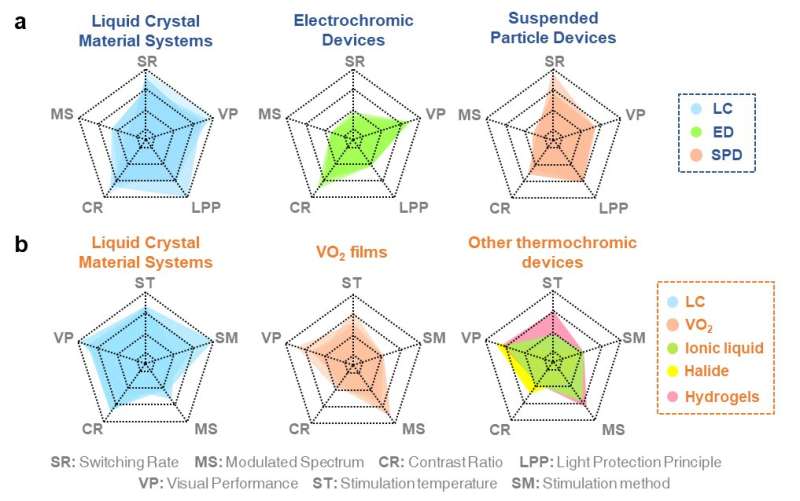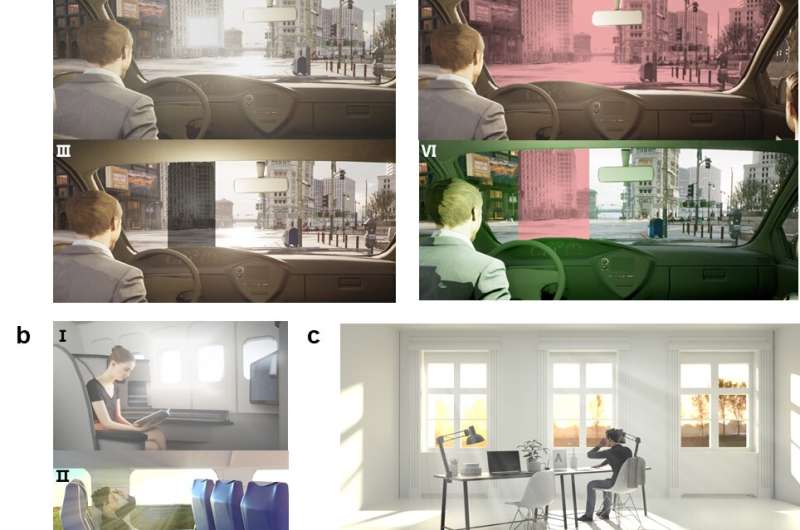This article has been reviewed according to Science X's editorial process and policies. Editors have highlighted the following attributes while ensuring the content's credibility:
fact-checked
peer-reviewed publication
trusted source
proofread
Advanced liquid crystal-based switchable optical devices for light protection applications

Human life is inextricably bound to light. Developments in science and technology have increased the popularity of artificial light and diversified the use of sunlight. However, inappropriate light radiation can be harmful to human health and well-being. As important channels for external light, windows play a vital role in the regulation of light in buildings, vehicles, and aircraft.
There is a need for windows with switchable optical properties to prevent or attenuate damage or interference to the human eye and light-sensitive instruments through inappropriate optical radiation. In recent years, smart materials have achieved rapid development, and transparent materials that can provide switchable optical properties have attracted a lot of attention from researchers. In this context, liquid crystals (LCs), owing to their rich responsiveness and unique optical properties, have been considered among the best candidates for advanced light protection materials.
In a new paper titled "Advanced liquid crystal-based switchable optical devices for light protection applications: principles and strategies," published in Light Science & Application, a team of scientists, led by Professor Jiaqi Zhu of China's Key Laboratory of Micro-systems and Micro-structures Manufacturing, Ministry of Education discusses the research progress and challenges of liquid crystal materials in the field of light protection.
They first discuss the specific light environment confronted by LC-based light protection and the existing light protection strategies. According to the source, light radiation can be classified as natural light or artificial light. Sunlight has a wide wavelength range (250nm-2500nm), a large change in radiation angle and a large irradiation area. Laser light has high power, narrow wavelength and fast response characteristics. Other high-intensity lighting, such as skylights and spotlights, have the same response rate as lasers and a wider spectral range than lasers. LC materials show superiority in response time and protection bandwidth compared to conventional electronically controlled color change materials. LC materials are excellent candidates for light protection because they have significant advantages over conventional thermochromic materials in terms of stimulation temperature and visible light transmission rate.

Second, the researchers introduce several classes of light modulation principles based on liquid crystal materials. From the perspective of light energy, there are three types of photoprotection principles for LCs: 1) conversion of incident light energy to other forms of energy; 2) transfer of incident light energy through reflected paths; and 3) transfer of incident light energy through scattering paths. They discuss the characteristics, advantages and applications of each of these three types of light protection principles for light protection devices.
Finally, they discuss current light protection strategies based on liquid crystal materials for different applications, and the problems and shortcomings of current strategies. In the presence of complex optical environments, comprehensive protection often requires that multiple mechanisms are coupled. The researchers propose recommendations for light protection strategies in different light environments. When applying light protection devices to vehicles, it is necessary to focus on transient light protection strategies; while for buildings, long-term light protection strategies are appropriate.
Although several types of light protection devices for LCs were studied, those for practical applications are still very limited. First, it is challenging to develop LC-based light protection devices that adapt to different external environments during long-term stable operation. Mature light protection devices for LCs should have high UV radiation tolerance and electrochemical stability. Second, in current commercial installations, there is a lack of LC-based light protection devices that flexibly adapt to protective requirements for different external environments. Third, these technologies face the challenge of ensuring good stability and homogeneity for commercial applications.
The researchers expect that thorough research on a new generation of intelligent optical limiting materials will address the above issues. They propose to intelligent optical limiting materials to solve the above problems completely. Programmable flexibility and self-adaptation will be critical in realizing optical materials for new demands. This system will not only provide protection from multiple wavelength bands but also respond quickly in complex environments, protect across the entire UV-visible-infrared spectrum, supply high-strength protection in some bands, and have long service life. The system should work well provided that the device is stable under high-power incident light and consumes small amounts of energy in the long-term protective state.
More information: Ruicong Zhang et al, Advanced liquid crystal-based switchable optical devices for light protection applications: principles and strategies, Light: Science & Applications (2023). DOI: 10.1038/s41377-022-01032-y
Journal information: Light: Science & Applications
Provided by Chinese Academy of Sciences





















